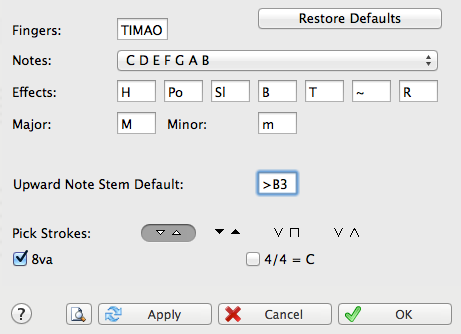Preferences
This tab allows you to customize the labels used by TablEdit to display the names of notes, the letters used for fingering indications and the abbreviations used for the most common effects.

Fingers
For the right hand, type the initials of the fingers in TIMRP order. These initials will be used to display the right hand fingerings.
By default, the fingers of the left hand are simply numbered 01234, from the thumb to the pinky. However, you can replace the 0 by a "T", which will change the display of the left hand fingerings.
Notes names
You can replace the letters C, D, E, F, G, A and B by their French equivalents Do, Ré, Mi, etc... or replace just the B natural by the H commonly used in Sweden and Germany.
Effects abbreviations
You may also elect to have no text displayed at all above the slurs indicating special effects.
Major / Minor
You can enter here your preferred abbreviation for the mode in the chord names.
Dulcimer Extra Fret
This field, which only appears if the current instrument has a diatonic neck (for example the dulcimer), allows you to change the characters(s) used by TablEdit to indicate that a note is played on an extra fret of the instrument. It may be "+" or ",5" or "#' etc.
Pitch change display
This field, which only appears if pitch changes have been entered in the score, allows you to choose how these pitch changes should be represented in the tablature.
Upward Note Stem Default
This field set the point at which note stems will be forced upwards without manual alteration. The default setting is >B1 (B in the first octave, i.e. the open second string of a guitar in standard tuning). The setting you actually use is a question of individual taste and needs. It should also be noted that the choice of stem default pitch can also be prefaced by "<" which will reverse the stem directions.
Pick stroke
This defines the symbols used for pick strokes added from either the "Pick strokes & Fingerings" dialog or from the "Hand" palette. Conventions and preferences for these vary from country to country and from player to player.
4/4 = C
As an option, you can elect to display the time signature using the 4/4 = C and 2/2 = "Cut" time conventions . In the latter case, don't forget to continue writing with 4/4 intervals i.e. based on 1/4 and 1/8th notes.
8va
If you select the "8va" option, 8va will be displayed and printed below the clef in the notation. This indicates that the actual pitch of the notes are, in reality, an octave lower than that indicated by the notation